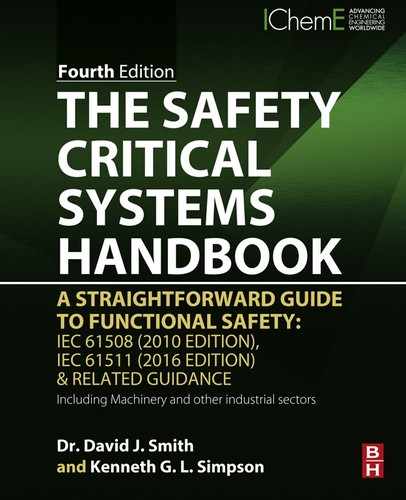Table of Contents
Part A. The Concept of Safety Integrity
Chapter 1. The Meaning and Context of Safety Integrity Targets
1.1. Risk and the Need for Safety Targets
1.2. Quantitative and Qualitative Safety Target
1.4. Steps in the Assessment Process
1.6. The Seven Parts of IEC 61508
1.7. HAZOP (Hazard and Operability Study)
Chapter 2. Meeting IEC 61508 Part 1
2.1. Establishing Integrity Targets
2.2. “As Low as Reasonably Practicable”
2.3. Functional Safety Management and Competence
2.5. Example Involving Both Individual and Societal Risk
Chapter 3. Meeting IEC 61508 Part 2
3.1. Organizing and Managing the Life Cycle
3.2. Requirements Involving the Specification
3.3. Requirements for Design and Development
3.4. Integration and Test (Referred to as Verification)
3.5. Operations and Maintenance
3.6. Validation (Meaning Overall Acceptance Test and the Close Out of Actions)
3.10. “Proven in Use” (Referred to as Route 2s in the Standard)
3.12. Conformance Demonstration Template
Chapter 4. Meeting IEC 61508 Part 3
4.1. Organizing and Managing the Software Engineering
4.2. Requirements Involving the Specification
4.3. Requirements for Design and Development
4.4. Integration and Test (Referred to as Verification)
4.5. Validation (Meaning Overall Acceptance Test and Close Out of Actions)
4.8. Alternative Techniques and Procedures
4.11. Conformance Demonstration Template
Chapter 5. Reliability Modeling Techniques
5.1. Failure Rate and Unavailability
5.2. Creating a Reliability Model
5.3. Taking Account of Auto Test
Chapter 6. Failure Rate and Mode Data
6.3. Data Ranges and Confidence Levels
Chapter 7. Demonstrating and Certifying Conformance
7.1. Demonstrating Conformance
7.2. The Current Framework for Certification
7.3. Self-Certification (Including Some Independent Assessment)
Part B. Specific Industry Sectors
Chapter 8. Second Tier Documents—Process, Oil and Gas Industries
8.4. ANSI/ISA-84.00.01 (2004)—Functional Safety, Instrumented Systems for the Process Sector
9.4. BS EN ISO 13850: 2015 Safety of Machinery—Emergency Stop—Principles for Design
Chapter 10. Other Industry Sectors
10.9. Stage and Theatrical Equipment
Part C. Case Studies in the Form of Exercises and Examples
Chapter 11. Pressure Control System (Exercise)
11.4. Reliability Block Diagram
11.7. Proposed Design and Maintenance Modifications
11.8. Modeling CCF (Pressure Transmitters)
11.9. Quantifying the Revised Model
11.11. Architectural Constraints
Chapter 12. Burner Control Assessment (Example)
Safety Integrity Study of a Proposed Replacement Boiler Controller
Chapter 13. SIL Targeting—Some Practical Examples
13.1. A Problem Involving EUC/SRS Independence
13.2. A Hand-held Alarm Intercom, Involving Human Error in the Mitigation
13.3. Maximum Tolerable Failure Rate Involving Alternative Propagations to Fatality
13.4. Hot/cold Water Mixer Integrity
13.5. Scenario Involving High Temperature Gas to a Vessel
Chapter 14. Hypothetical Rail Train Braking System (Example)
14.6. Overall Safety-Integrity
Chapter 15. Rotorcraft Accidents and Risk Assessment
15.2. Floatation Equipment Risk Assessment
Chapter 16. Hydroelectric Dam and Tidal Gates
16.1. Flood Gate Control System
16.2. Spurious Opening of Either of Two Tidal Lock Gates Involving a Trapped Vessel
Appendix 1. Functional Safety Management
Appendix 2. Assessment Schedule
Appendix 3. BETAPLUS CCF Model, Scoring Criteria
Appendix 4. Assessing Safe Failure Fraction and Diagnostic Coverage
Appendix 5. Answers to Examples
Appendix 7. Quality and Safety Plan
